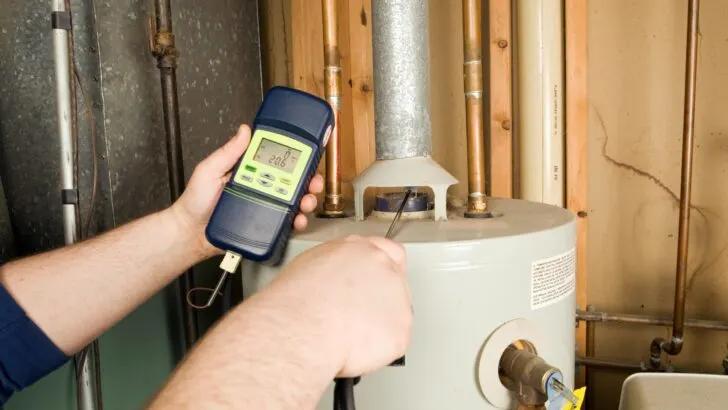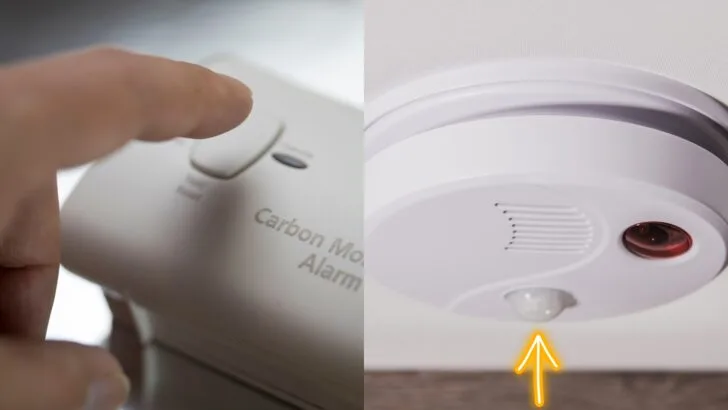Is your RV (or home) carbon monoxide detector beeping? This post is all about why it’s beeping, what to do about it, and what not to do… ever!
A carbon monoxide detector’s chirping sound in the middle of the night may seem annoying when it’s occurring, but it’s a small price to pay for the fact that the chirping/beeping sound could very well be saving your life and the lives of those you love, including children and pets for whom you’re responsible.
This could easily be among our most important posts in 20 years, not only for RV owners, but for sticks & bricks homeowners as well.
So, let’s get to it…
- 1) What Is Carbon Monoxide?
- 2) What Is a Carbon Monoxide Detector?
- 3) What Does It Mean When My Carbon Monoxide Detector is Chirping?
- 4) How to Test a Carbon Monoxide Detector
- 5) How Long Does an RV Carbon Monoxide Detector Last?
- 6) Where Can I Buy a New Carbon Monoxide Detector for My RV?
- 7) Have You Checked Your RV’s Carbon Monoxide Detector Lately?
- 8) Free RVing Tips, Tricks, Reviews, Giveaways & More
What Is Carbon Monoxide?
Carbon monoxide (CO) is an odorless, tasteless, invisible gas produced by gas-powered appliances.
In an RV, this might include your furnace, water heater, stove, oven, 2-way or 3-way RV refrigerator, and/or generator.
The fact that the gas is odorless, colorless, tasteless, and invisible is the reason why it’s so dangerous. A person can be overcome by carbon monoxide, suffering CO poisoning (which can lead to death), without realizing that it’s happening.
Carbon monoxide in your RV, (or in any enclosed space, including your sticks & bricks home), can be deadly.
This is why a properly working carbon monoxide detector is so important in any enclosed space, including an RV.

Any gas-powered appliance has the potential to create a carbon monoxide danger. Here you see a home gas water heater being checked for a CO leak.
What Is a Carbon Monoxide Detector?
A carbon monoxide detector senses the presence/buildup of a carbon monoxide leak and has an alarm that sounds loudly to alert you to the danger.
This is why a carbon monoxide detector beeping is something that should never be ignored, including in the middle of the night.
Annoying? Perhaps. But it also could be life-saving.
Remember – a CO detector has an alarm for a reason, and detectors start beeping for a reason. If your carbon monoxide alarm is annoying you, then it’s doing its job.
What Does It Mean When My Carbon Monoxide Detector is Chirping?
A carbon monoxide detector beeping is alerting you to potential serious danger. It may also be alerting you to the fact that your CO detector isn’t working properly and needs your immediate attention.
This isn’t a “false alarm”. It’s another important indication from your CO detector.
There are a few different reasons for carbon monoxide detectors chirping or beeping.
We’ll share them with you here, but we strongly encourage you to never ignore a chirping or beeping CO detector, regardless of the pattern of sound you’re hearing.
Following are three different types of sounds you may hear from a CO detector. The most important thing to keep in mind is that a carbon monoxide detector beeping is demanding your attention in one way or another.
Different detector brands may vary, so be sure to read your owner’s manual. But these are the common basics…
4 Beeps + Pause
This pattern indicates an emergency situation and is the most important reason why we install carbon monoxide detectors.
Four beeps and a pause is indicative of the presence of a dangerous level of carbon monoxide. It’s your CO detector’s way of alerting you to the fact that it has detected carbon monoxide gas in your home or RV and that you need to get all people and pets out of the home or rig and into fresh air immediately and call 911 or the fire department.
1 Beep/Minute
When your carbon monoxide alarm is beeping (or “chirping” — short beeps) about once per minute, it’s telling you that you need to replace the batteries (or the detector) immediately.
A low battery alert may not be an emergency, but it’s also nothing to ignore. When you’re living in an enclosed space where there are fuel-burning appliances, you must have a CO detector that is working optimally.
If you’re hearing one beep per minute, then change those batteries (or replace that detector) right away.
This is why it’s a good idea to have extra batteries on hand at all times. When your carbon monoxide detector is chirping, even if it’s in the middle of the night, you need to be able to replace those batteries to make it optimally effective as a detector that could save your life and the lives of those who are living with you.
5 Beeps/Minute
When your carbon monoxide detector is beeping five short beeps per minute, it’s telling you that the detector itself is at the end of its effective life, and it’s time to replace the unit.
When this happens, you need to replace your CO detector immediately, because it’s not functioning optimally to protect you and your family.
How to Test a Carbon Monoxide Detector
It’s a good habit to test your detectors at least once a month to ensure they’re working properly.

A carbon monoxide detector has a test button, allowing you to make sure that yours is in good working condition. All safety detectors should be tested regularly.
On a typical CO detector, there’s a test button. To test the functionality of your carbon monoxide detector, press and hold the test button on the detector.
When you press and hold the button, you should hear 4 beeps, a pause, then 4 additional beeps for about 5-6 seconds. Again, check your owner’s manual for variations between brands.
The video below shows the testing process and what will happen when you test your CO detector:
PRO TIP: There are two common myths about CO — First, that it’s heavier than air, meaning that carbon monoxide alarms should be installed low on the wall. Second, that carbon monoxide is lighter than air, so detectors should be installed on the ceiling.
Neither of these is actually true. While CO is slightly lighter than air, it’s so minimal that it diffuses evenly throughout the room. So it doesn’t matter where the detector is mounted.
Some units combine CO and propane detectors, which must be mounted low on the wall due to the heavier weight of propane gas. Other models combine CO detection with smoke detection. This requires mounting the unit on the ceiling because smoke rises.
How Long Does an RV Carbon Monoxide Detector Last?
The answer to this question depends on what type of carbon monoxide detector you use in your RV. But most rigs are originally equipped with a built-in CO detector.
As you may recall from our post entitled “What Is an RV Propane Detector?“, an RV’s built-in detectors have a useful lifespan. And even if they’re still working, they really should be changed regularly in accordance with that time frame.
Remember – carbon monoxide can kill you. It can kill your entire family as you sleep. It’s well worth the few dollars it’ll cost you to replace your detector when it nears the end of its useful lifespan.
With all of that said, most CO detectors last between 5 and 7 years. Some are even designed to last 10 years.
However, even if the battery is still good and the detector is exhibiting no signs of being at the end of its lifespan, it’s a good idea to replace your detector when it reaches its expiration date. Every carbon monoxide detector should have a date stamped right on the unit (often on the back).
The reason why it’s so important to replace CO detectors while they’re still performing well is because, with time, the sensor in a detector loses its ability to function optimally. This means that it isn’t working optimally to detect carbon monoxide in your home or RV.
When you replace your detectors as required, you’re assured of having a high-functioning sensor protecting your life and the lives of your loved ones.
Where Can I Buy a New Carbon Monoxide Detector for My RV?
If you use small portable CO detectors in any given space, you can pick up a new one at almost any hardware store or big box stores like Walmart, Target, etc.
However, if you need to replace your RV’s built-in carbon monoxide detector, you’ll want to check the model number of the unit currently installed in your RV, and order accordingly. We find that replacing current gear with identical units (or as close as possible) usually makes things easier.
Your home or RV may have a combination CO & smoke detector, or a combination CO & propane detector, so note of the exact type you need to replace.
Following are examples of a few different types of CO detectors.
Ceiling/Wall Mount CO Detector:
- HIGHEST QUALITY, most accurate electrochemical co sensor technology
- CONVENIENT, end of life chirping signal
RV CO & LPG Detector:
- Double-Duty Alarm Detects Both Gas Leaks And Co Gas Simultaneously
- Reliable 12V Power Means No Missing Or Dead Batteries To Replace. Operating Temperature: minus 40° F To plus 158° F
Combined CO & Smoke Detector:
- 2 units in 1: unit alerts you to smoke & carbon monoxide by sounding a loud, 85-decibel alarm & sounding voice alerts
- Photoelectric sensor technology senses visible fire particles, while a electrochemical sensor detects CO gas
Have You Checked Your RV’s Carbon Monoxide Detector Lately?
Now’s a great time to check your CO detector, as well as your smoke and propane detectors.
Working alarms in your RV can be life-saving. It’s never worth putting off this important piece of RV maintenance for even a minute. If you’re thinking about it, TEST IT.
PRO TIP: If you’ve got a smartphone, you can set a reminder to check your detectors monthly.
As we suggested in our recent post on getting your RV ready for travel, checking all of your detectors/alarms is among the most important things to do in preparation for every road trip.
Safe travels!
Free RVing Tips, Tricks, Reviews, Giveaways & More
Subscribe to our daily newsletter! We’ve been full-time RVers for 20 years (!) and share everything we’ve learned about RVing in our daily blog posts. Join our online community to receive a wealth of great RVing knowledge delivered right to your inbox.
Whether this is your first time on the road or you’re a seasoned full-timer, you’ll love the wide range of RVing topics we cover. Don’t miss a single article or any of our famous RV gear Giveaways — Subscribe today!





Camper Jack
Tuesday 9th of May 2023
We've had a few boondocking occasions, while running our generator, that our detector would start screaming, scaring us and the dog. The muffler is right outside our big slide. Turns out, when the wind is just right (or wrong), that it manages to bring the exhaust inside.
We ended up purchasing a Gen-Turi exhaust gizmo, and it resolved our issues.